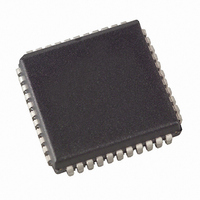AT89LS53-12JI Atmel, AT89LS53-12JI Datasheet - Page 19

AT89LS53-12JI
Manufacturer Part Number
AT89LS53-12JI
Description
IC 8051 MCU FLASH 12K 44PLCC
Manufacturer
Atmel
Series
89LSr
Datasheet
1.AT89LS53-12AC.pdf
(35 pages)
Specifications of AT89LS53-12JI
Core Processor
8051
Core Size
8-Bit
Speed
12MHz
Connectivity
SPI, UART/USART
Peripherals
POR, WDT
Number Of I /o
32
Program Memory Size
12KB (12K x 8)
Program Memory Type
FLASH
Ram Size
256 x 8
Voltage - Supply (vcc/vdd)
2.7 V ~ 6 V
Oscillator Type
Internal
Operating Temperature
-40°C ~ 85°C
Package / Case
44-PLCC
Lead Free Status / RoHS Status
Contains lead / RoHS non-compliant
Eeprom Size
-
Data Converters
-
Other names
AT89LS5312JI
Available stocks
Company
Part Number
Manufacturer
Quantity
Price
Company:
Part Number:
AT89LS53-12JI
Manufacturer:
ATMEL
Quantity:
1 831
Part Number:
AT89LS53-12JI
Manufacturer:
ATMEL/爱特梅尔
Quantity:
20 000
7. To verify the byte just programmed, bring pin P2.7
8. Repeat steps 3 through 7 changing the address and
9. Power-off sequence:
DATA Polling
The AT89LS53 features DATA Polling to indicate the end of
a write cycle. During a write cycle in the parallel or serial
programming mode, an attempted read of the last byte writ-
ten will result in the complement of the written datum on
P0.7 (parallel mode), and on the MSB of the serial output
byte on MISO (serial mode). Once the write cycle has been
completed, true data are valid on all outputs, and the next
cycle may begin. DATA Polling may begin any time after a
write cycle has been initiated.
Ready/Busy
The progress of byte programming in the parallel program-
ming mode can also be monitored by the RDY/BSY output
signal. Pin P3.4 is pulled Low after ALE goes High during
programming to indicate BUSY. P3.4 is pulled High again
when programming is done to indicate READY.
Program Verify
If lock bits LB1 and LB2 have not been programmed, the
programmed Code can be read back via the address and
data lines for verification. The state of the lock bits can also
be verified directly in the parallel programming mode. In the
serial programming mode, the state of the lock bits can only
be verified indirectly by observing that the lock bit features
are enabled.
Chip Erase
In the parallel programming mode, chip erase is initiated by
using the proper combination of control signals and by
holding ALE/PROG low for 10 ms. The Code array is writ-
ten with all “1”s in the Chip Erase operation.
In the serial programming mode, a chip erase operation is
initiated by issuing the Chip Erase instruction. In this mode,
chip erase is self-timed and takes about 16 ms.
During chip erase, a serial read from any address location
will return 00H at the data outputs.
0851C–MICRO–3/06
to “L” and read the programmed data at pins P0.0 to
P0.7.
data for the entire 12K-byte array or until the end of
the object file is reached.
Set XTAL1 to “L”.
Set RST and EA pins to “L”.
Turn V
CC
power off.
Serial Programming Fuse
A programmable fuse is available to disable Serial Pro-
gramming if the user needs maximum system security. The
Serial Programming Fuse can only be programmed or
erased in the Parallel Programming Mode.
The AT89LS53 is shipped with the Serial Programming
Mode enabled.
Reading the Signature Bytes: The signature bytes are
read by the same procedure as a normal verification of
locations 030H and 031H, except that P3.6 and P3.7 must
be pulled to a logic low. The values returned are as follows:
Programming Interface
Every code byte in the Flash array can be written, and the
entire array can be erased, by using the appropriate combi-
nation of control signals. The write operation cycle is self-
timed and once initiated, will automatically time itself to
completion.
All major programming vendors offer worldwide support for
the Atmel microcontroller series. Please contact your local
programming vendor for the appropriate software revision.
Serial Downloading
The Code memory array can be programmed using the
serial SPI bus while RST is pulled to V
face consists of pins SCK, MOSI (input) and MISO (output).
After RST is set high, the Programming Enable instruction
needs to be executed first before program/erase operations
can be executed.
An auto-erase cycle is built into the self-timed programming
operation (in the serial mode ONLY) and there is no need
to first execute the Chip Erase instruction unless any of the
lock bits have been programmed. The Chip Erase opera-
tion turns the content of every memory location in the Code
array into FFH.
The Code memory array has an address space of 0000H to
2FFFH.
Either an external system clock is supplied at pin XTAL1 or
a crystal needs to be connected across pins XTAL1 and
XTAL2. The maximum serial clock (SCK) frequency should
be less than 1/40 of the crystal frequency. With a 12 MHz
oscillator clock, the maximum SCK frequency is 300 KHz.
(030H) = 1EH indicates manufactured by Atmel
(031H) = 63H indicates 89LS53
CC
AT89LS53
. The serial inter-
19

















